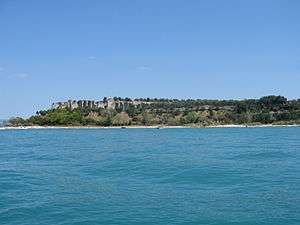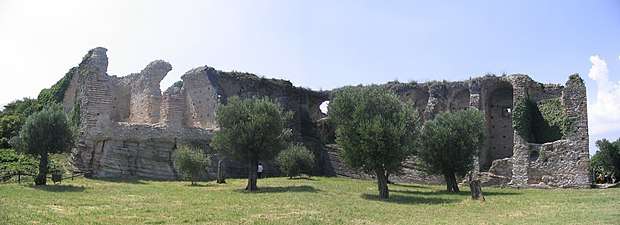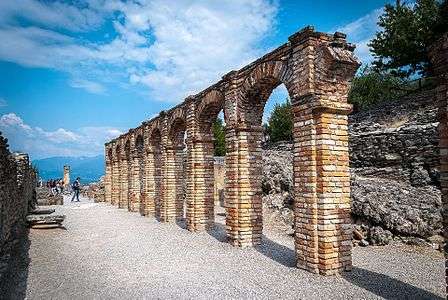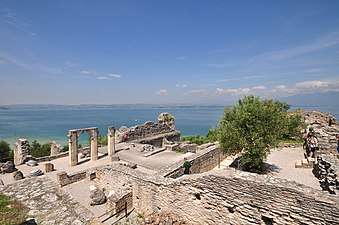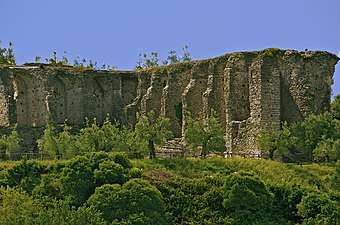Grottoes of Catullus
Grottoes of Catullus is the name given to the ruins of a Roman villa which was built at the end of the 1st century BC and the beginning of the 1st century AD at the northernmost end of the peninsula of Sirmione on the southern shore of Lake Garda.[1]
Grotte di Catullo | |
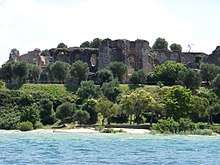 Grottoes seen from the lake | |
 Shown within Italy | |
| Location | Sirmione, Province of Brescia, Lombardy, Italy |
|---|---|
| Coordinates | 45°30′6″N 10°36′22″E |
| Type | Dwelling |
| History | |
| Periods | Roman Imperial |
| Cultures | Roman |
| Site notes | |
| Condition | Ruined |
| Ownership | Public |
| Public access | Yes |
| Website | Grotte di Catullo |
History
The large villa, under which structures of the 1st century BC were found, was built at the beginning of the 1st century AD. The villa must have been already abandoned in the 3rd century when part of its architectural decoration was reused in the other Roman villa in Sirmione, the one located on the present-day Via Antiche Mura. Between the 4th and 5th centuries the imposing surviving structures of the villa were included in the fortifications that enclosed the Sirmione peninsula and burials were built inside the remains of the Roman building, used a cemetery.
Over the centuries several chroniclers and travelers visited the ruins, but the first concrete studies on them were carried out only in 1801 by General Lacombe-Saint-Michel, commander of the Napoleonic army. Subsequently, the Veronese count Giovanni Girolamo Orti Manara carried out some excavations and surveys, whose results were published in 1856.
In 1939 the National Superintendence for Archaeological Heritage started an extensive program of excavations and restorations, finally acquiring the entire area in 1948 to allow adequate protection of the complex and in its natural environment.
During the 1990s further studies confirmed that the construction was carried out through a unitary project, which defined the orientation and distribution of the internal spaces according to a precise criterion of axiality and symmetry. In 1999 an Archeological Museum collecting finds from the area was inaugurated.
Site description

The archaeological complex, still partially unearthed today, covers an area of about two hectares. The villa has a rectangular plan with two foreparts on the north and south sides. To overcome the inclination of the rocky bank on which the building was set, large support substructures were created in the northern part and considerable cuts were made to model the rocky bank.
The main floor, corresponding to the owner's home, is the most damaged, both because it was the most exposed and because the villa, after its abandonment, has been a quarry for materials for several centuries. The intermediate and lower floors instead are better preserved.
The main entrance to the building was located in the southern forepart. The villa was characterized by long porches and terraces open towards the lake along the east and west sides, communicating to the north with a large belvedere terrace, equipped with a velarium.
Along the western side, today you can visit the cryptoporticus, a long walk once covered. The residential parts of the building were located in the north and south areas, while the central part, made up today of the Grande Oliveto ("Big Olive Grove"), was occupied by a garden. On the southern side, under an opus spicatum floor, there is a large cistern almost 43 meters long, which collected the water necessary for daily use. The large thermal sector of the villa, consisting of several rooms located in the south-western area, including a swimming pool, was probably obtained at the beginning of the 2nd century.
The various rooms of the villa have suggestive conventional names, derived from a consolidated local tradition or from interpretations and names given during the first excavations. Among the ruins can be found l'Aula dei tre pilastri ("The Three-pillar Hall"), il Lungo corridoio ("The Long corridor"), la Trifora del Paradiso ("The Trifora of Heaven"), il Grande Pilone ("The Big Pylon"), la Grotta del Cavallo ("The Horse Cave") and l'Aula dei Giganti ("The Hall of Giants").
In popular culture
The site was one of the sets in the Academy awards movie Call Me by Your Name (2017).[2][3][4]
Gallery
External links
| Wikimedia Commons has media related to Grottoes of Catullus. |
